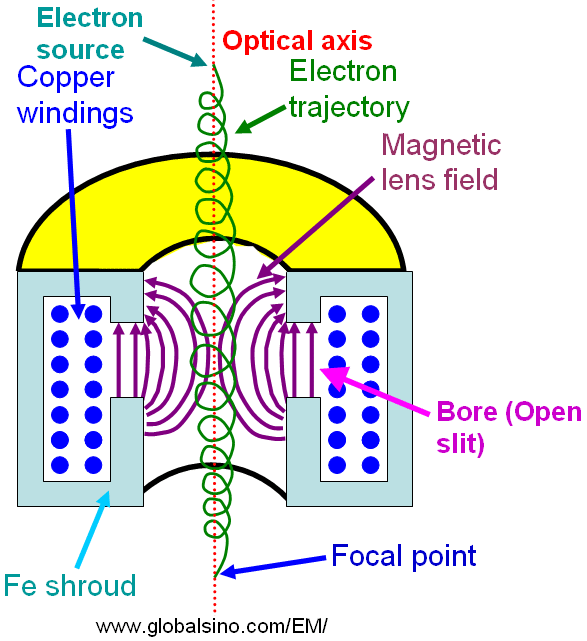=================================================================================
High-energy charged particles, e.g. incident electrons in electron microscopes (EMs) and Ga ions in focused ion beam (FIB), behave sometimes like particles, sometimes like waves. Even though those charged particles have both wave and particle properties, the information transfer properties of the lens can only be understood in the model of waves. Therefore, the EMs and FIB can only be described within the framework of wave optics.
Electron microscopes employ electrostatic and electromagnetic lenses so that they can control the electron beams and form images.
As shown in Figure 3756, electromagnetic lenses consist of windings of wire through which the electric current is applied. These configurations create a strong magnetic field where the incident electron beam must pass. The electrons follow a helical trajectory which converges at a fine focal point after they emerge from the lens. Here, the DC(direct current)-powered magnets behave similar to converging glass lenses in optical microscopes.

| Figure 3756. Schematic illustration of electrons passing through electromagnetic lenses. Magnetic field strength can be increased by using a soft ferromagnetic core like Fe shroud (iron core). |
Different from ideal lenses, the real magnetic lenses in EMs are far from ideal and will change the phase and amplitude of the electron wave as it passes through the lenses because the electron lenses cannot be made free from aberrations. The most severe aberrations are the spherical aberrations and the chromatic aberrations. This is especially true for the objective lens which, being the strongest lens in the EMs (e.g. TEMs), will have the largest effects. There are additional aberrations which should be considered at higher spatial resolutions, e.g. more widely categorized by coherent and incoherent aberrations.
Note that in EMs except for alignment deflectors, stigmators, and multipole aberration correctors, all the other conventional optical lenses are cylinder symmetric.
In modern EMs, by taking advantage of computer control, it is convenient to switch between different operation modes, such as SEM, STEM, bright-field and dark-field TEM, nanobeam electron diffraction (NBED), and CBED, once their lens settings have been preset.
|